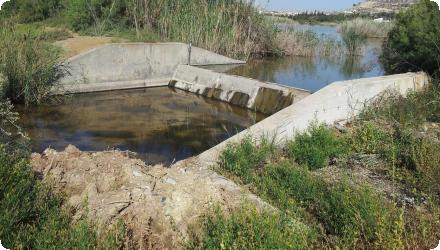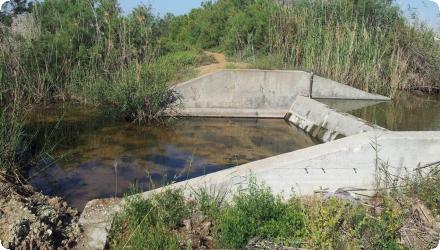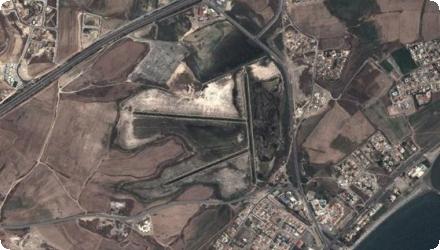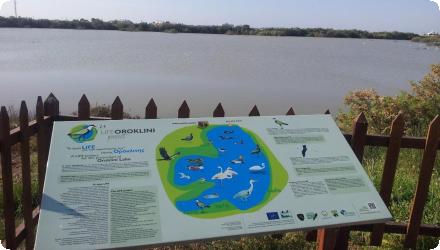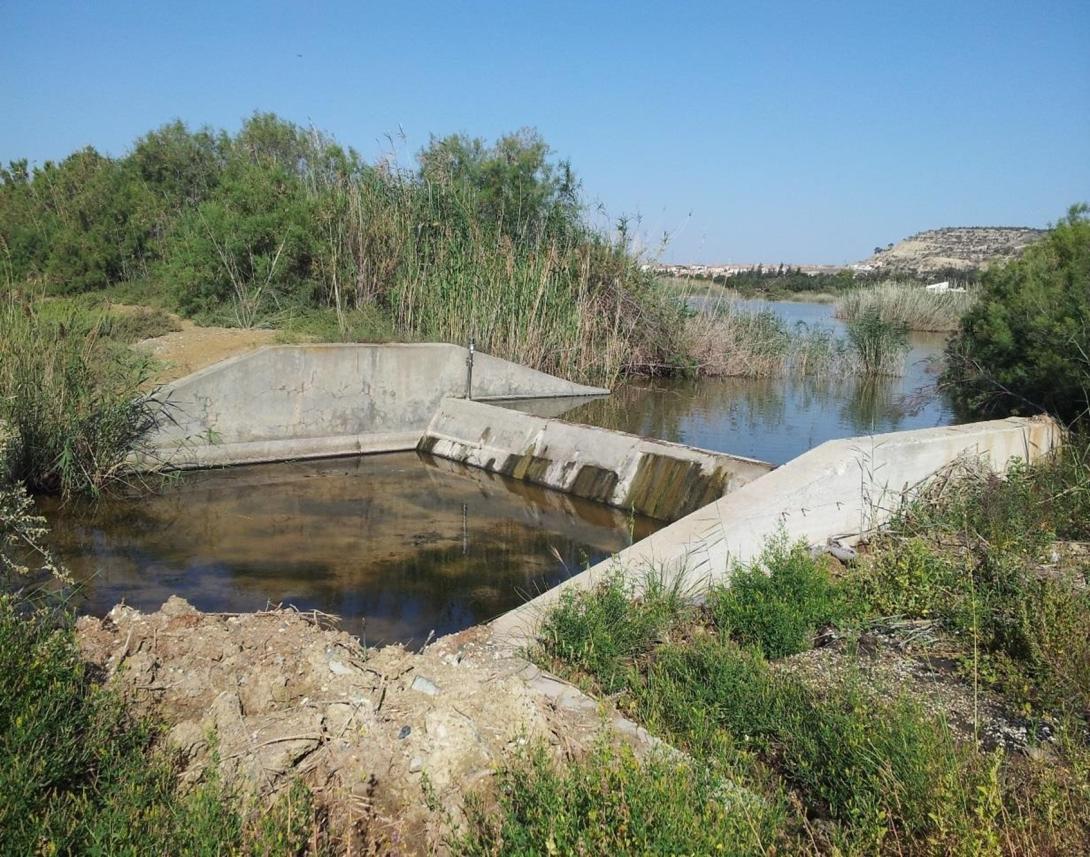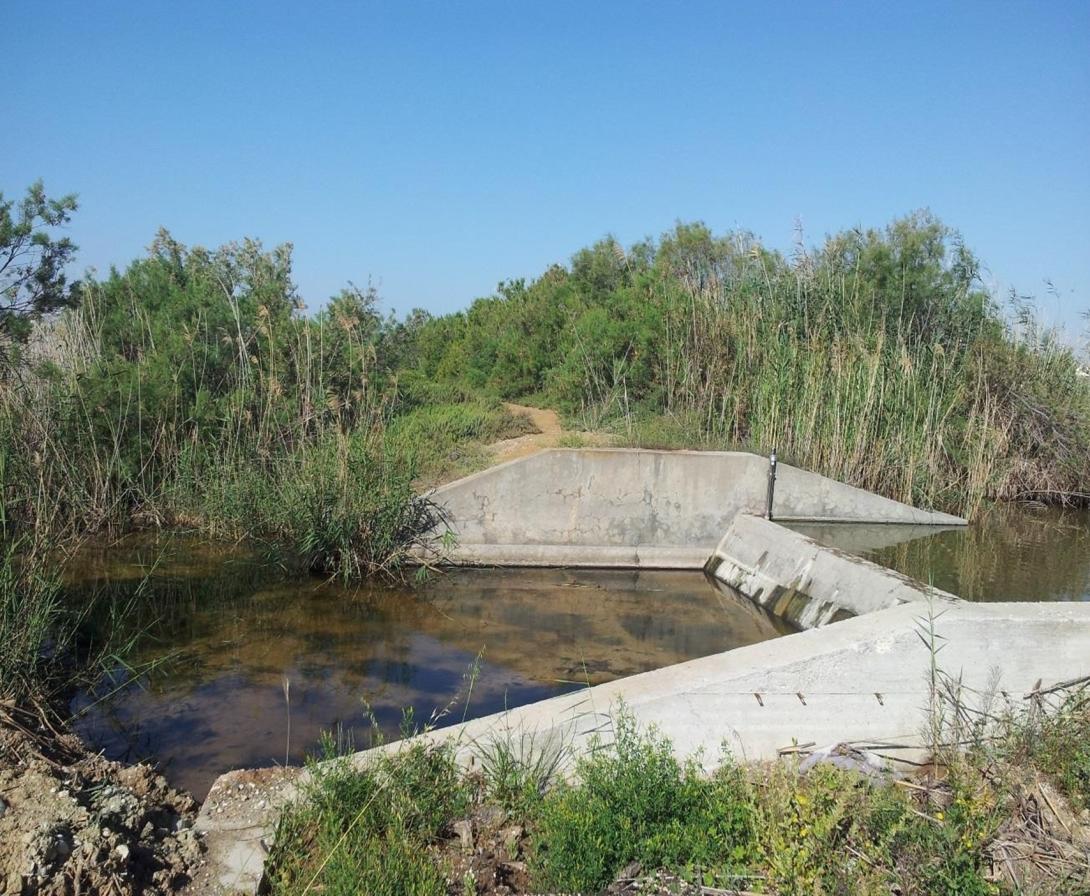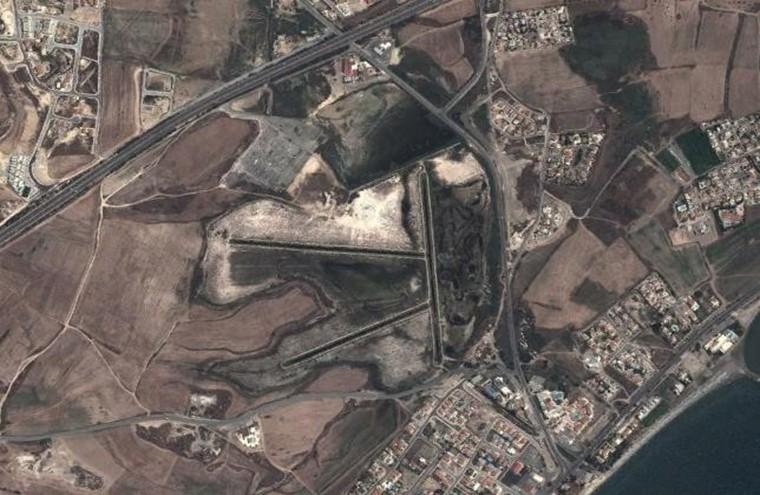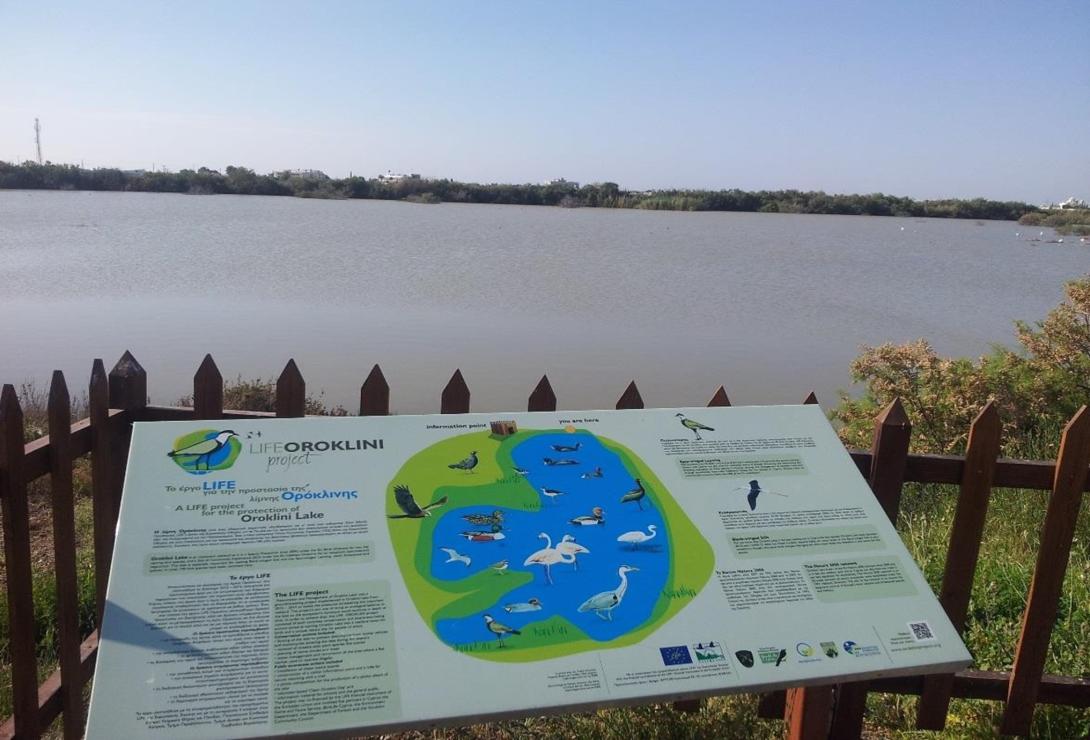Last update
2025
Summary
Oroklini Lake lies near Larnaca within Oroklini village. The wetland was modified in the mid-1940s to promote desiccation for health reasons. NWRM actions aimed to retain water and restore habitats for two key breeding species (Black-winged Stilt, Spur-winged Lapwing) and wider biodiversity, including small hydraulic works in the upper basin.
In 2012–2014 the LIFE “Oroklini” project restored and managed the site (water-level management, nesting islets, fencing and visitor facilities), and it was later recognised as a Best LIFE project (2018).
Since 2014, After-LIFE management continues: monthly waterbird counts and nesting surveys, predator monitoring, reed control, and operation of water-control structures to release excess water during floods; bird-collision “diverters” were also installed on power lines.
Recent science characterises Oroklini as a brackish lake (mean salinity ~7.4‰, ≤20‰) with occasional high phytoplankton abundance, influenced by catchment dominated by artificial and agricultural land uses, nformation valuable for water-level and vegetation management.
Under LIFE IP “Pandoteira” (2023–2029), measures relevant to Oroklini include access management to reduce disturbance, water-level plans, reed management and control of non-native predators.
A local issue flagged in late-2023 concerns an upstream runoff channel to the lake that has not been cleaned for decades, raising flood-risk and maintenance needs.
In 2012–2014 the LIFE “Oroklini” project restored and managed the site (water-level management, nesting islets, fencing and visitor facilities), and it was later recognised as a Best LIFE project (2018).
Since 2014, After-LIFE management continues: monthly waterbird counts and nesting surveys, predator monitoring, reed control, and operation of water-control structures to release excess water during floods; bird-collision “diverters” were also installed on power lines.
Recent science characterises Oroklini as a brackish lake (mean salinity ~7.4‰, ≤20‰) with occasional high phytoplankton abundance, influenced by catchment dominated by artificial and agricultural land uses, nformation valuable for water-level and vegetation management.
Under LIFE IP “Pandoteira” (2023–2029), measures relevant to Oroklini include access management to reduce disturbance, water-level plans, reed management and control of non-native predators.
A local issue flagged in late-2023 concerns an upstream runoff channel to the lake that has not been cleaned for decades, raising flood-risk and maintenance needs.
Position
Latitude
34.967222
Longitude
33.650833
Project
NWRM
National Id
Cyprus_03
Installation date
2012
Implementation Status
Contact
Ayis Iacovides, I.A.CO
RBD code
CY001
Transboundary
0
Photo gallery
Location of the project
Oroklini lake is a small shallow brackish lake located close to the coast of Larnaca, within the Oroklini municipality premises.
NUTS Code
CY00 - Κύπρος (Kýpros)
Project's objectives
Bring target birds to favourable conservation status and adopt a legally binding Action Plan for the SPA.
Species targets (FRVs) set in the management plan: Spur-winged Lapwing Vanellus spinosus: 15 breeding pairs; Black-winged Stilt Himantopus himantopus: 60 breeding pairs.
Habitat target: maintain ~53 ha of halophytic communities in favourable condition (SCI 53.47 ha; SPA 56.43 ha).
Works & measures: water-management (sluice repair/re-connection of basins), creation of nesting islets, fencing, removal of invasives and planting natives, plus visitor facilities (two hides, information kiosk) and awareness actions.
Species targets (FRVs) set in the management plan: Spur-winged Lapwing Vanellus spinosus: 15 breeding pairs; Black-winged Stilt Himantopus himantopus: 60 breeding pairs.
Habitat target: maintain ~53 ha of halophytic communities in favourable condition (SCI 53.47 ha; SPA 56.43 ha).
Works & measures: water-management (sluice repair/re-connection of basins), creation of nesting islets, fencing, removal of invasives and planting natives, plus visitor facilities (two hides, information kiosk) and awareness actions.
Involved Partners
| Authority type | Authority name | Role | Comments |
|---|---|---|---|
Climate zone
warm temperate dry
Temperature
19,6
Precipitation
351,5
Annual rainfall range
300 - 600 mm
Runoff
0,0135
Runoff coefficient
0,45
Runoff coefficient range
0.3 - 0.5
Runoff range
0 - 150 mm
Evapotranspiration
2259
Imperviousness
45
Elevation range
1 m
Slope range
2-5%
Soil type
Solonchak
Vegetation class
Reedbeds and halophytes
Water bodies: Ecological Status
Unknown
Water bodies: Chemical Status
Failing to achieve good
Project scale
Micro
Project scale specification
Small wetland
Performance timescale
1 - 4 years
Project area
295
Area specifications
The catchment area of the lake is 295 hectares. This can be divided to:
- 6 hectares of the upper basin were water is retained
- 31.5 hectares of the lower basin
- 257.5 hectares the catchment basin of the lake
- 6 hectares of the upper basin were water is retained
- 31.5 hectares of the lower basin
- 257.5 hectares the catchment basin of the lake
Area subject to Land use change or Management/Practice change (ha)
91
Size
91
Size unit
m2
Lifespan
> 20 years
The measures were designed bearing in mind the ecosystem functions and species needs, the achievement of good water quality, the implementation of time-resilient measures and the creation of wetland conditions highly acceptable by the public.
100-year storm
Constraints are: urbanization of the area surrounding the lake and demand for new road crossings. Similarly, the urbanization and lack of sewage network causes deterioration of quality of surface water, and future changes of its quantity.
The lowland features of the area and its location favorable to certain bird species and the presence of surface runoff as well as the state ownership of the area are excellent preconditions.
Positive influence effectiveness
The construction of an earth embankment in the area since the 40’s provided a retention structure that would prove to be a valuable element in the progress of the project. Its presence and the restoration of the sluice, enabled the retentiion of water.
Negative influence effectiveness
The low water permeability of the lake sediments does not allow for groundwater recharge and therefore water retention can only by achieved only within the surface water body
Total cost
€1,050,000
Costs total information
The measure is under study. The full investment will be evaluated after the completion of all relevant studies
Costs investment information
The measure exists only partly. On going studies aim to design in full the NWRM and management of the wetland. Full capital cost is still not known
Costs capital
1,000,000
Costs operational
25,000
Costs operational information
The costs will be known once the full management plan including necessary monitoring is established. These might involve analyses of water, fauna observations, assistant†™s visit to check water level recorder and other installations.
Costs maintenance
25,000
Costs maintenance information
Expenses will be identified after completion of NWRM design. Additional costs will involve protection of quality of water flowing to the wetland due to urbanization and encroachment of urban development.
Financing authorities
Type of funding
EU-funds: LIFE+
Type of funding
National funds
Compensations
0
Policy context
Several hydraulic measures were applied in the mid 40’s in order to desiccate the Oroklini lake due to health concerns such as malaria, as well as other mosquito-borne diseases. These measures included the creation of drainage canals, plantation of Eucalyptus sp. and Acacia sp. trees in the area, the earth fill in parts of the lake for cultivations expansion and the creation of an earth embankment of 292m long in order to restrain water in the upper lake basin. The above led to ecosystem degradation and therefore management measures were considered urgent, in order to retain water quantities and restore the wetland.
As part of the wetland restoration, water retention measures were aiming at secure water availability in the upper basin of the lake and maintain high water level in order to facilitate the needs of avifauna, instead of flowing and spreading in the lower, larger basin, thus creating small ponds that would dry up in a short time.
As part of the wetland restoration, water retention measures were aiming at secure water availability in the upper basin of the lake and maintain high water level in order to facilitate the needs of avifauna, instead of flowing and spreading in the lower, larger basin, thus creating small ponds that would dry up in a short time.
Land ownership
The wetland core is public/state land, restoration included the reclamation of public land from agriculture.
Community involvment
Yes
Design consultation activity
| Activity stage | Name | Key issues | Comments |
|---|
Policy target
| Target purpose |
|---|
|
Improved Biodiversity
|
|
Oher Societal Benefits
|
|
Peak-flow reduction
|
|
Oher Societal Benefits
|
Target Remarks
Regulation of hydrological cycle and water flow
Regulation of the chemical status of freshwater
Natural assimilation (purification) of effluents through dilution, dispersion, and physic-chemical processes
Restore ecosystem habitats, functions and support biodiversity.
Regulation of the chemical status of freshwater
Natural assimilation (purification) of effluents through dilution, dispersion, and physic-chemical processes
Restore ecosystem habitats, functions and support biodiversity.
Policy pressure
| Pressure directive | Relevant pressure |
|---|---|
|
WFD identified pressure
|
Degradation of physicochemical and ecological status of the water body.
|
|
Other EU
|
Habitats directive : Important habitats degradation
|
|
Other EU
|
Birds Directive: Species and their habitats degradation
|
Policy impact
| Impact directive | Relevant impact |
|---|---|
|
WFD identified impact
|
Alteration of ecological and physicochemical status
|
|
WFD identified impact
|
Altered habitats due to morphological changes
|
|
Other EU
|
Habitats directive : degradation of important habitats
|
|
Other EU
|
Birds’ directive: degradation of bird species populations and their habitats.
|
Requirement directive
| Requirement directive | Specification |
|---|---|
|
WFD-achievement of good ecological status
|
|
|
WFD-achieving objectives for Protected areas
|
Enforce the community mandates for protected areas
|
|
Other EU
|
Habitats directive : Preservation of important habitats
|
|
The Birds and Habitat Directives
|
Birds directive: Preservation of important bird species and their habitats
|
Policy challenges requirements
The "Cyprus’s Biodiversity Strategy Action Plan" is in line with the "EU Biodiversity Strategy" and the "Global Biodiversity Strategy". It aims at "halting the loss of biodiversity and the degradation of ecosystem services by 2020, and restoring them in so far as feasible, and in parallel strengthen Cyprus’ contribution to averting global biodiversity loss". The current project aimed at restoring Oroklini lake in order to provide the appropriate habitats for two target species, in order to sustain their populations.
Contractual arrangements
1
| Arrangement type | Responsibility | Role | Name | Comments |
|---|---|---|---|---|
Part of wider plan
0
Wider plan type
| Wider plan type | Wider plan focus | Name | Comments |
|---|
No specific monitoring needs. Monitoring can be commenced for water level, water quality, species and habitats in order to better understand ecosystem processes and apply better management practices.
Maintenance
Reed beds management in order to avoid abstraction of the inflow streams and the wetland encroachment by reed beds
Catchment outlet
A monthly water operation study of the Oroklini Lake, under scenarios of drought, average and wet conditions was carried out on the basis of the hydro-climatological conditions of the years 1968 to 2011. This was used to evaluate impact on fauna.
Comparison of pre- and post- measures application.
Leisure area within an urban environment. Educational area for young people.
Elevated amounts of water and for a greater period have resulted in increased biodiversity in the area and especially increased numbers of wading birds. This has raised the public interest for the wetland and mild tourist activity has been observed.
Elevated amounts of water and for a greater period have resulted in increased biodiversity in the area and especially increased numbers of wading birds. This has raised the public interest for the wetland and mild tourist activity has been observed.
Retained water
7,1
Retained water unit
mio m3/month
Information on retained water
In an average year the lake created by the dam is dry in June, July, August and September. The lake is full for the rest of the months except of May (nearly half full) and October (nearly full). Spills maintain wetlands downstream the dam
Increased water storage
0,017
Increased water storage unit
mio m3/month
Information on increased water storage
The water stored in the lake created by the retention dam in an average year is 0,017 million m3 per month. The wetland collected certain, reduced, quantities of water for some periods of the year which soon evaporated
Runoff reduction
6600
Runoff reduction unit
m3/month
Information on runoff reduction
The average monthly water reduction by the NWRM is estimated to be of the order of 6600 m3. The control could be higher if the controlled releases to the downstream wetlands are considered.
Information on Increased infiltration
Infiltration rate over 3mm/h
Information on Restoring hydraulic connections
Although a temporal lake, water was present in the lake until September; i.e. 1-2 month more than previous years.
Ecosystem erosion control
1
Information on Ecosystem erosion control
Although of minor impact. Sediments are deposited upstream the dam.
Water quality overall improvements
Positive impact-WQ improvement
Information on Water quality overall improvements
The presence of stored water reduces the salinity of the water. Increased water residence was observed in 2014. The lake was flooded during summer despite the low precipitation.
Soil quality overall soil improvements
Neutral impact-no change in SQ status
Information on Soil quality overall soil improvements
No impact on soil quality is observed or expected.
1
The conditions in the area where two very important birds included in Annex I of EU Directive on Birds (Vanellus spinosus and Himantopus himantopus) nest, are greatly improved. The lake hosts some 186 kinds of which 69 are included in the Directive.
Nesting Spurwinged Lapwing and Stonecurlew were recorded on the restored field. First record of Little Egret nesting. Kentish Plover nests. The last breeding record was in 2007. Cattle Egrets nested for the first time. On nesting islets created Spurwinged Lapwings nested. Eels were observed in the lake for the first time.
Hydrology & plankton: 2018–2019 monitoring across Cyprus’s natural lakes found Oroklini is brackish (salinity ~3–20.4‰) and had the highest phytoplankton richness (27 taxa) among the lakes studied; abundance varied widely seasonally. This refines lake functioning post-works.
Nesting Spurwinged Lapwing and Stonecurlew were recorded on the restored field. First record of Little Egret nesting. Kentish Plover nests. The last breeding record was in 2007. Cattle Egrets nested for the first time. On nesting islets created Spurwinged Lapwings nested. Eels were observed in the lake for the first time.
Hydrology & plankton: 2018–2019 monitoring across Cyprus’s natural lakes found Oroklini is brackish (salinity ~3–20.4‰) and had the highest phytoplankton richness (27 taxa) among the lakes studied; abundance varied widely seasonally. This refines lake functioning post-works.
Ecosystem impact climate regulation
No specific impact
Information on Ecosystem impact climate regulation
Very minor impact might be expected on climate regulation.
Key lessons
Proper water management with small scale measures can restore wetlands within urban areas for furthering nature conservation objectives such as wet grassland conditions for breeding rare birds. This at the same time may offer minor flood protection.
Small, targeted water-management and habitat works can rapidly restore breeding conditions for priority waders in an urban fringe wetland, provided governance and long-term management are in place.
Quantified conservation targets (FRVs) & a binding Action Plan help keep focus after LIFE funding ends.
Monitoring shows progress and gaps: while bird/habitat targets are structured, water-quality pressures at catchment scale persist and need cross-sector action beyond the site fence.
People & access matter: facilities and outreach increased the site’s profile and support, but surrounding development and drainage infrastructure must be actively managed to avoid undermining gains.
Small, targeted water-management and habitat works can rapidly restore breeding conditions for priority waders in an urban fringe wetland, provided governance and long-term management are in place.
Quantified conservation targets (FRVs) & a binding Action Plan help keep focus after LIFE funding ends.
Monitoring shows progress and gaps: while bird/habitat targets are structured, water-quality pressures at catchment scale persist and need cross-sector action beyond the site fence.
People & access matter: facilities and outreach increased the site’s profile and support, but surrounding development and drainage infrastructure must be actively managed to avoid undermining gains.
Success factor(s)
| Success factor type | Success factor role | Comments | Order |
|---|---|---|---|
|
Attitude of decision makers
|
main factor
|
<p>Insistence and pressure by Department of Environment , BirdLife Cyprus and Game Fund</p>
|
1
|
|
Financing possibilities
|
main factor
|
<p>Financial support by LIFE under the project LIFE10 NAT/CY/716</p>
|
2
|
Driver
| Driver type | Driver role | Comments | Order |
|---|---|---|---|
|
Organisation committed to it
|
main driver
|
Dept. of Environment, BirdLife Cyprus, Game Fund, Local Village Council
|
1
|
Flexibility adaptability
The baseline conditions present in this case study were the dry conditions and desiccation of the lake due to water management measures taken in the past, the presence of alien species and the wetland encroachment by locals. Therefore targeted measures were taken in order to deal with these conditions. These measures can be adapted to different conditions depending on these conditions nature. For instance increased flows can be tackled by the current works.
Transferability
This application can be selected in lake ecosystems which have been degraded due to bad water management practices and/or have been degraded by decreased water inflow. Additionally the creation of retention ponds can be serve with similar measures such as the creation of embankments and weirs. The restoration of riparian buffers can be realized also by removing alien species and planting native plants. Reclamation of floodplain is another associated measure that can be used in other occasions.
Basin characteristics influence
The urban expansion in the drainage basin of the lake, increases point and diffuse pollution sources and other pressures. It can have adverse effects on the wetland quality, affect the measures effectiveness on biodiversity and water purification.
Source(s)
English
